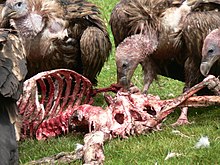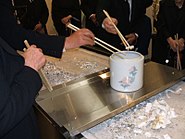
A | B | C | D | E | F | G | H | CH | I | J | K | L | M | N | O | P | Q | R | S | T | U | V | W | X | Y | Z | 0 | 1 | 2 | 3 | 4 | 5 | 6 | 7 | 8 | 9
A funeral is a ceremony connected with the final disposition of a corpse, such as a burial or cremation, with the attendant observances.[1] Funerary customs comprise the complex of beliefs and practices used by a culture to remember and respect the dead, from interment, to various monuments, prayers, and rituals undertaken in their honour. Customs vary between cultures and religious groups. Funerals have both normative and legal components. Common secular motivations for funerals include mourning the deceased, celebrating their life, and offering support and sympathy to the bereaved; additionally, funerals may have religious aspects that are intended to help the soul of the deceased reach the afterlife, resurrection or reincarnation.
The funeral usually includes a ritual through which the corpse receives a final disposition.[2] Depending on culture and religion, these can involve either the destruction of the body (for example, by cremation, sky burial, decomposition, disintegration or dissolution) or its preservation (for example, by mummification). Differing beliefs about cleanliness and the relationship between body and soul are reflected in funerary practices. A memorial service (or celebration of life) is a funerary ceremony that is performed without the remains of the deceased person.[3]
The word funeral comes from the Latin funus, which had a variety of meanings, including the corpse and the funerary rites themselves. Funerary art is art produced in connection with burials, including many kinds of tombs, and objects specially made for burial like flowers with a corpse.
Overview

Funeral rites are as old as human culture itself, pre-dating modern Homo sapiens and dated to at least 300,000 years ago.[4] For example, in the Shanidar Cave in Iraq, in Pontnewydd Cave in Wales and at other sites across Europe and the Near East,[4] archaeologists have discovered Neanderthal skeletons with a characteristic layer of flower pollen. This deliberate burial and reverence given to the dead has been interpreted as suggesting that Neanderthals had religious beliefs,[4] although the evidence is not unequivocal – while the dead were apparently buried deliberately, burrowing rodents could have introduced the flowers.[5]
Substantial cross-cultural and historical research document funeral customs as a highly predictable, stable force in communities.[6][7] Funeral customs tend to be characterized by five "anchors": significant symbols, gathered community, ritual action, cultural heritage, and transition of the dead body (corpse).[2]
Religious funerals
Bahá'í Faith
Funerals in the Bahá'í Faith are characterized by not embalming, a prohibition against cremation, using a chrysolite or hardwood casket, wrapping the body in silk or cotton, burial not farther than an hour (including flights) from the place of death, and placing a ring on the deceased's finger stating, "I came forth from God, and return unto Him, detached from all save Him, holding fast to His Name, the Merciful, the Compassionate." The Bahá'í funeral service also contains the only prayer that is permitted to be read as a group – congregational prayer, although most of the prayer is read by one person in the gathering. The Bahá'í decedent often controls some aspects of the Bahá'í funeral service, since leaving a will and testament is a requirement for Bahá'ís. Since there are no Bahá'í clergy, services are usually conducted under the guise, or with the assistance of, a Local Spiritual Assembly.[8]
Buddhist

A Buddhist funeral marks the transition from one life to the next for the deceased. It also reminds the living of their own mortality. Cremation is the preferred choice,[9] although burial is also allowed. Buddhists in Tibet perform sky burials where the body is exposed to be eaten by vultures. The body is dissected with a blade on the mountain top before the exposure. Crying and wailing is discouraged and the rogyapas (body breakers who perform the ritual) laugh as if they are doing farm work. Tibetan Buddhists believe that a light-hearted atmosphere during the funeral helps the soul of the dead to get a better afterlife. After the vultures consume all the flesh the rogpyas smash the bones into pieces and mix them with tsampa to feed to the vultures.[10]
Christian

Congregations of varied denominations perform different funeral ceremonies, but most involve offering prayers, scripture reading from the Bible, a sermon, homily, or eulogy, and music.[2][11] One issue of concern as the 21st century began was with the use of secular music at Christian funerals, a custom generally forbidden by the Catholic Church.[12]
Christian burials have traditionally occurred on consecrated ground such as in churchyards. There are many funeral norms like in Christianity to follow.[13] Burial, rather than a destructive process such as cremation, was the traditional practice amongst Christians, because of the belief in the resurrection of the body. Cremations later came into widespread use, although some denominations forbid them. The US Conference of Catholic Bishops said "The Church earnestly recommends that the pious custom of burying the bodies of the deceased be observed; nevertheless, the Church does not prohibit cremation unless it was chosen for reasons contrary to Christian doctrine" (canon 1176.3).[14]
Zdroj:https://en.wikipedia.org?pojem=Funerary_ritesText je dostupný za podmienok Creative Commons Attribution/Share-Alike License 3.0 Unported; prípadne za ďalších podmienok. Podrobnejšie informácie nájdete na stránke Podmienky použitia.
Antropológia
Aplikované vedy
Bibliometria
Dejiny vedy
Encyklopédie
Filozofia vedy
Forenzné vedy
Humanitné vedy
Knižničná veda
Kryogenika
Kryptológia
Kulturológia
Literárna veda
Medzidisciplinárne oblasti
Metódy kvantitatívnej analýzy
Metavedy
Metodika
Text je dostupný za podmienok Creative
Commons Attribution/Share-Alike License 3.0 Unported; prípadne za ďalších
podmienok.
Podrobnejšie informácie nájdete na stránke Podmienky
použitia.
www.astronomia.sk | www.biologia.sk | www.botanika.sk | www.dejiny.sk | www.economy.sk | www.elektrotechnika.sk | www.estetika.sk | www.farmakologia.sk | www.filozofia.sk | Fyzika | www.futurologia.sk | www.genetika.sk | www.chemia.sk | www.lingvistika.sk | www.politologia.sk | www.psychologia.sk | www.sexuologia.sk | www.sociologia.sk | www.veda.sk I www.zoologia.sk






